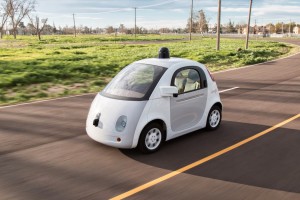Google is putting out the “Help Wanted” sign, and it could signal a major shift in plans for its Google X autonomous vehicle program.
For the last several years, the high-tech firm has said it doesn’t want to produce its own vehicles but would rather find partners – a term used by Google X CEO John Krafcik during a visit to Detroit last month. But among the dozens of jobs being advertised, at least some put a focus on manufacturing skills.
That includes one for a manufacturing process engineer who would be responsible for “designing factory assembly stations, optimizing production floor layout, automating critical manufacturing processes and approving fixture designs used in the assembly of electronic modules for the self-driving car.”
Google claims to have logged 100s of thousands of miles running a series of autonomous vehicle prototypes, and the Google X unit has been rolling out a fleet of bubble-shaped prototypes that are being put into operation near the company’s campuses in Silicon Valley and Austin, Texas.
Meanwhile, the National Highway Traffic Safety Administration this week issued a letter to Google saying it would consider the company’s artificial intelligence technology the equivalent of a human driver. That move came a month after U.S. Transportation Secretary Anthony Foxx announced the department’s intent to speed up the development and commercialization of autonomous vehicle technology.
(Google gets major endorsement from NHTSA. Click Here for the latest.)
Google is widely considered the leader in the field, a position underscored by a recent study released by Britain’s Juniper Research. The question has been how the firm, best known for its search and online advertising technology, would put its self-driving system into production.
Chris Urmson, Krafcik’s second-in-command, had repeatedly indicated Google would not want to enter automotive manufacturing itself. Krafcik himself seemed to bolster that view during and after a speech he gave in Detroit in January.
“We understand no one goes this alone,” said Krafcik, a former CEO of Hyundai Motor America and, in an earlier incarnation, a senior engineer at Ford. “In the next stage of our project, we’ll be partnering more and more and more. We have to figure out the right set of partnerships to unlock.”
(Google wants partners, but Krafcik won’t saw if Ford will be one. Click Here for more.)
But that position might be evolving, at least if the 36 jobs Google wants to fill come as any indication. Among the other openings, it wants those with experience in robotics, sensors and controls, as well as a global supply chain manager, and a manufacturing supplier quality engineer who will oversees processes, equipment, tools gauges and fixtures for raw material, mechanical components and mechanical assemblies.”
It is, of course, possible, that those manufacturing posts would be filled while working with a partner who would actually handle the production job. As the year began, rumors widely circulated suggesting Google was ready to partner with Ford Motor Co. Ford is considered a relative latecomer in autonomous research and is racing to catch up to competitors including not only Google but General Motors, Nissan and Daimler AG.
Neither Ford nor Google will discuss a possible relationship.
Getting into automotive manufacturing would be a costly venture, even for a company as flush with cash and with the market valuation of a Google. But finding a way to monetize its autonomous vehicle technology is itself a major challenge.
And Google could face competition from other high-tech entrants looking to take a lead in the nascent market for self-driving vehicles. Apple is widely believed to be developing its own program under the codename Project Titan. And a Chinese billionaire has put up a chunk of the funding for a California-based start-up, Faraday Future, which is already setting up a plant outside Las Vegas where it plans to build battery-powered vehicles that could use autonomous technology.
Tesla Motors, meanwhile, recently released the most advanced, semi-autonomous vehicle system currently in use on public roads, its AutoPilot technology.
Google may feel its best opportunity lies in going it alone, or it might be exploring the challenges it would face with automotive manufacturing as one of its options.
(Transportation Sec Foxx intends to ease rules, encourage autonomous vehicle development. Click Here for more.)



I hope the Feds soon get off their arses and establish safety, security, manufacturing, service and operation laws and requirements for the AV industry which as has been demonstrated is like the Wild West of yore where anything goes and there is no one in control. So far authorities world wide have abdicated their responsibilities to protect the populace and define all of the AV requirements necessary. Perhaps they will wait until people die to get off their duffs.